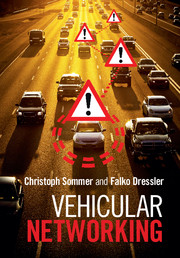3 - Inter-vehicle communication
Published online by Cambridge University Press: 18 December 2014
Summary
Communication between vehicles (and between vehicles and available infrastructure) is the topic of this chapter. Essentially, we give a basic introduction to inter-vehicle communication (IVC) identifying the key concepts in the safety as well as in the non-safety application domains. For this, we derive all the relevant communication concepts and solutions for those applications and, most importantly, identify the requirements such as maximum delays, minimum dissemination range, or minimum data rates. Furthermore, we present an overview on the possible communication paradigms, such as whether information is to be exchanged without the help of any available infrastructure or whether infrastructure elements – roadside units (RSUs), parked vehicles, or even widely deployed cellular networks – can be used for the information exchange.
The scope of this chapter is to introduce IVC as an active research field. The main motivation is to become familiar with the field to a level that helps one to understanding the fundamental concepts and their limitations. All the communication principles outlined will be studied in greater detail in the following chapters.
This chapter is organized as follows.
• Applications (Section 3.1) – In this section, we introduce the field starting with typical applications for IVC. We will show that the scope and character of these applications vary widely, which complicates the development of common and generalized IVC protocols.
• Requirements and components (Section 3.2) – Starting from knowledge about IVC applications, we derive requirements on IVC solutions and study metrics to assess their effectiveness. In a second part, we introduce all the communication entities involved and possible mechanisms for information exchange.
• Concepts for inter-vehicle communication (Section 3.3) – This section can be regarded as the main part of this chapter. We broadly study all the communication principles and protocols that have been considered for IVC. This overview explains why the different protocols have been studied and what their main advantages and disadvantages are.
• Fundamental limits (Section 3.4) – We conclude this chapter by discussing fundamental limits for IVC.
[…]
- Type
- Chapter
- Information
- Vehicular Networking , pp. 38 - 105Publisher: Cambridge University PressPrint publication year: 2014
- 1
- Cited by



